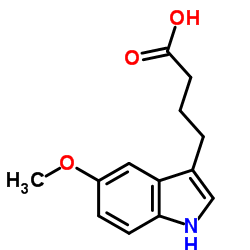Roxindole

Roxindole structure
|
Common Name | Roxindole | ||
|---|---|---|---|---|
| CAS Number | 112192-04-8 | Molecular Weight | 346.47 | |
| Density | 1.173g/cm3 | Boiling Point | 575.7ºC at 760mmHg | |
| Molecular Formula | C23H26N2O | Melting Point | N/A | |
| MSDS | N/A | Flash Point | 302ºC | |
Use of RoxindoleRoxindole (EMD 49980), an indot-alkyl-pipenidine, is a potent agonist at dopamine autoreceptors, with an affinity for the D2-like subtype in the low nanomolar range. Roxindole can be used for the research of positive and negative schizophrenic symptoms. Roxindole is a 5-HT1A agonist and 5-HT uptake inhibitor with high affinity for 5-HT1A (IC50=0.9 nM). Antipsychotic and antidepressant activities[1][2][3]. |
| Name | roxindole |
|---|---|
| Synonym | More Synonyms |
| Description | Roxindole (EMD 49980), an indot-alkyl-pipenidine, is a potent agonist at dopamine autoreceptors, with an affinity for the D2-like subtype in the low nanomolar range. Roxindole can be used for the research of positive and negative schizophrenic symptoms. Roxindole is a 5-HT1A agonist and 5-HT uptake inhibitor with high affinity for 5-HT1A (IC50=0.9 nM). Antipsychotic and antidepressant activities[1][2][3]. |
|---|---|
| Related Catalog | |
| In Vivo | Roxindole (EMD 49980) (1, 3, 10 mg/kg; s.c) inhibits both effects of 8-OH- DPAT (flat body and forepaw treading) in normal rats (male Wistar 200-350g)[3]. Roxindole inhibits apomorphine-induced climbing in mice and stereotyped behavior in rats with ED50s of 1.4 mg/kg s.c. and 0.65 mg/kg s.c., respectively, and inhibits conditioned avoidance response in rats (ED50=1.5 mg/kg s.c.)[4]. |
| References |
| Density | 1.173g/cm3 |
|---|---|
| Boiling Point | 575.7ºC at 760mmHg |
| Molecular Formula | C23H26N2O |
| Molecular Weight | 346.47 |
| Flash Point | 302ºC |
| Exact Mass | 346.20500 |
| PSA | 39.26000 |
| LogP | 4.92340 |
| Vapour Pressure | 7.46E-14mmHg at 25°C |
| Index of Refraction | 1.651 |
| HS Code | 2933990090 |
|---|
|
~% 
Roxindole CAS#:112192-04-8 |
| Literature: Lange, Jos H. M.; De Jong, Johannes C.; Sanders, Hans J.; Visser, Geb M.; Kruse, Chris G. Bioorganic and Medicinal Chemistry Letters, 1999 , vol. 9, # 7 p. 1055 - 1056 |
|
~% 
Roxindole CAS#:112192-04-8 |
| Literature: Bottcher; Barnickel; Hausberg; Haase; Seyfried; Eiermann Journal of Medicinal Chemistry, 1992 , vol. 35, # 22 p. 4020 - 4026 |
|
~% 
Roxindole CAS#:112192-04-8 |
| Literature: Bottcher; Barnickel; Hausberg; Haase; Seyfried; Eiermann Journal of Medicinal Chemistry, 1992 , vol. 35, # 22 p. 4020 - 4026 |
|
~% 
Roxindole CAS#:112192-04-8 |
| Literature: Bottcher; Barnickel; Hausberg; Haase; Seyfried; Eiermann Journal of Medicinal Chemistry, 1992 , vol. 35, # 22 p. 4020 - 4026 |
|
~% 
Roxindole CAS#:112192-04-8 |
| Literature: Lange, Jos H. M.; De Jong, Johannes C.; Sanders, Hans J.; Visser, Geb M.; Kruse, Chris G. Bioorganic and Medicinal Chemistry Letters, 1999 , vol. 9, # 7 p. 1055 - 1056 |
| HS Code | 2933990090 |
|---|---|
| Summary | 2933990090. heterocyclic compounds with nitrogen hetero-atom(s) only. VAT:17.0%. Tax rebate rate:13.0%. . MFN tariff:6.5%. General tariff:20.0% |
| Roxindole |
| RoxindoleHCl |
| Roxindole hydrochloride,3-[4-(3,6-Dihydro-4-phenyl-1(2H)-pyridinyl)butyl]-1H-indol-5-olhydrochloride |
| ROXINDOLE HYDROCHLORIDE |
![5-methoxy-3-[3-(1,2,3,6-tetrahydro-4-phenyl-1-pyridyl)butyl]indole structure](https://image.chemsrc.com/caspic/264/143682-61-5.png)



